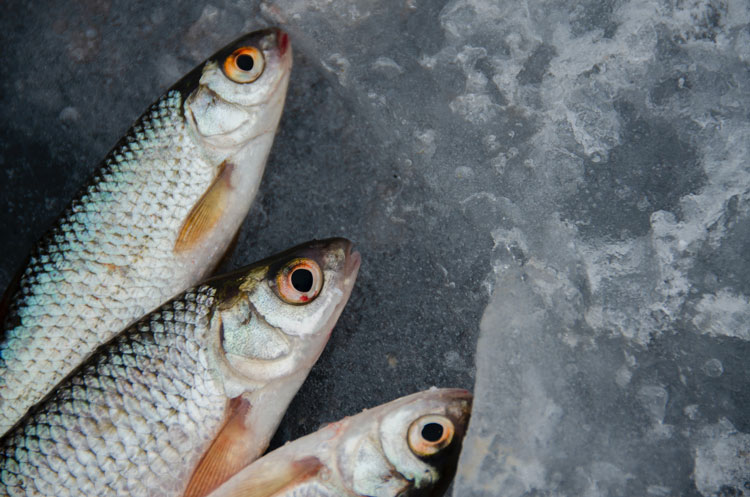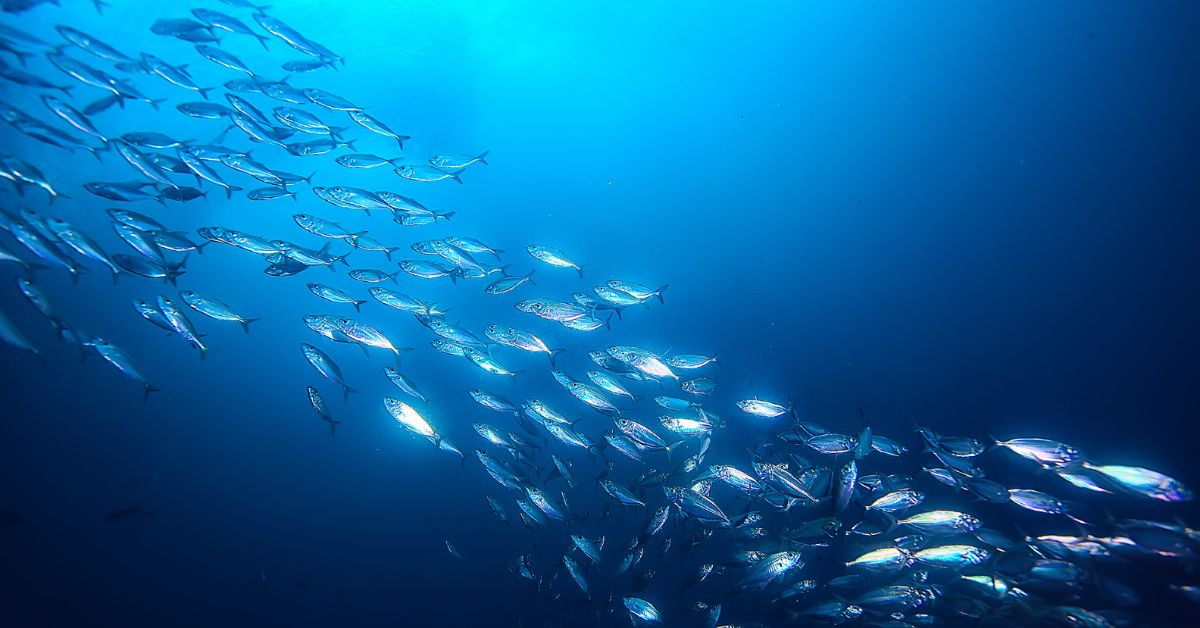

Raise your hand if you’ve ever had a friend or family member say to you, “Oh, I gave up meat for my health. I only eat seafood now.” Perhaps you’ve had similar thoughts. The health risks associated with processed and red meat consumption are nearly indisputable now among health organizations and professionals.[1-3] Additionally, it’s hard to argue that we can continue to feed the global population with land animals due to concerns of antibiotic resistance, greenhouse gas emissions, and human rights issues on factory farms and in slaughterhouses.[4-6] Somehow fish has become the darling of health and environment advocates for its proposed health benefits and booming market of “sustainable” fisheries. However, the stories we’re being fed about the benefits of fish are just as murky as our polluted rivers and oceans.
The Story About Fish That We’re Told
Fish is touted as a key component to any healthy eating pattern by many prominent public health and nutrition organizations. The American Heart Association, the Academy of Nutrition and Dietetics, the Dietary Guidelines for Americans, and the Harvard Healthy Eating Plate all recommend consuming fish as a healthy protein source to lower our risks for heart disease.[7-10] The logic behind these recommendations stems from a few perspectives.
First, fish and seafood are prominent in the Mediterranean diet, which also consists of large amounts of fruits and vegetables, whole grains, nuts and seeds, olive oil, and moderate amounts of alcohol.[8] The Mediterranean diet has been touted for its effects on cardiovascular disease and type 2 diabetes prevention.[11,12] Second, fish is praised for its high proportion of polyunsaturated fats, particularly long-chain omega-3 fatty acids, which have been known to have anti-inflammatory effects on our bodies and reduce risk of heart disease.[13,14] You might have heard that certain nuts and seeds also contain omega-3 fats. However, omega-3 fats found in plant foods come in the form alpha-linolenic acid (ALA). ALA must be converted to long-chain eicosapentaenoic acid (EPA) and docosahexaenoic acid (DHA) in animals in order to facilitate its anti-inflammatory effects; the rationale behind recommending fish over plant sources of omega-3s is due to concerns of low conversion rates in humans.[15]
Somehow fish has become the darling of health and environment advocates for its proposed health benefits and booming market of “sustainable” fisheries. However, the stories we’re being fed about the benefits of fish are just as murky as our polluted rivers and oceans.

The Holes in the Story
The stories we have been told about fish are rooted in reductionist and Eurocentric perspectives in health and nutrition research. But look a bit closer, and you start to see the holes.
First, the conversion of ALA to EPA and DHA is positively influenced by the amount of ALA, as well as the ratio of ALA to omega-6 fats that are pro-inflammatory, that one consumes.[16-18] ALA in and of itself also has beneficial effects on serum triglyceride levels comparable to EPA and DHA.[19] As Americans began to adopt the Standard American Diet (SAD), rich in processed plant foods, such as added vegetable oils, the ratio of omega-6 to omega-3 fatty acids consumed increased, while the presence of EPA and DHA in our cell membranes has declined[20](Blasbalg). Conversely, whole plant foods, such as nuts, seeds, and dark leafy greens are rich ALA; thus, diets rich in these whole plant foods may similarly protect heart health due to ALA and other anti-inflammatory molecules.[20] Furthermore, what is often underreported is the choline content in fish and its detrimental impacts on cardiovascular disease. While choline is an essential and important nutrient for cell membrane signaling, lipid metabolism, and brain development, an excess amount is problematic.[21] Choline is found in high amounts in red meats, eggs, and fish.[22] Bacteria in our gut metabolize choline into trimethylamine (TMA), which is absorbed into our bloodstreams and oxidized into trimethylamine N-oxide (TMAO).[24] TMAO is a small molecule that has been linked to increased risk of cardiovascular disease.[23,25] So, if fish contains different nutrients that are both protective and detrimental to heart health, it begs the question if fish is truly the darling of healthy eating patterns, such as the Mediterranean diet. A closer look at the waters fish inhabit may answer the question.
As ocean pollution becomes more prevalent globally, the concern of heavy metal accumulation in seafood and poisoning in human consumers increases. Heavy metals, such as mercury, can have toxic effects on all parts of the body, including the digestive, immune, and nervous systems.[26] Individuals who consume higher amounts of fish have higher blood mercury levels.[27,28] The Dietary Guidelines for Americans recommend that pregnant women consume up to 12 ounces of seafood per week because of this concern over heavy metal poisoning on fetal cognitive development.[29] And while they specify to consume certain fish that are lower in mercury,[29] why take that risk on your health and your child’s?
It is a flawed argument to attribute disease prevention characteristics to specific foods rather than looking at the totality of eating and living patterns. While fish is prevalent in the Mediterranean diet, so are other foods, such as fruits, vegetables, legumes, nuts, and seeds, that are also inversely associated with heart disease, diabetes, and all-cause mortality.[30-32] Additionally, these food components are not unique to the Mediterranean: diets centered around whole plant foods are prominent in almost all traditional diets around the world. The traditional diet of Okinawans, individuals from Japan’s most southern prefecture, share many characteristics with the Mediterranean diet, including fish, but it is much lower in total fat.[33] Yet, the Okinawans were among the longest living populations in the world prior to the westernization of their livelihoods.[34,35] Most American, Latin American, and African cuisines focus on whole plant foods as well. In fact, the westernization of any diet is the true culprit for increased chronic disease risk in populations.[36]

Fish is just one example of a single food glorified to superfood status. As Nelson Huber-Disla previously reported, this focus on superfoods can be misleading and even dangerous, but it’s much easier to convince people to buy and eat more of one food than it is to shift their entire way of eating. So, the next time you’re considering adding a food into your diet for one or two specific nutrients, try zooming out to look at the full picture. Are there other components of those foods that may be harmful? Or should you be more concerned about the healthfulness of your pattern of eating?
References
- Micha R, Michas G, Mozaffarian D. Unprocessed red and processed meats and risk of coronary artery disease and type 2 diabetes–an updated review of the evidence. Curr Atheroscler Rep. 2012;14(6):515-524. doi:10.1007/s11883-012-0282-8
- Rodriguez C, McCullough ML, Mondul AM, et al. Meat consumption among Black and White men and risk of prostate cancer in the Cancer Prevention Study II Nutrition Cohort. Cancer Epidemiol Biomarkers Prev. 2006;15(2):211-216. doi:10.1158/1055-9965.EPI-05-0614
- World Health Organization. Q&A on the carcinogenicity of the consumption of red meat and processed meat. World Health Organization. https://www.who.int/news-room/q-a-detail/q-a-on-the-carcinogenicity-of-the-consumption-of-red-meat-and-processed-meat. Published October 26, 2015. Accessed October 3, 2020.
- Saenz RA, Hethcote HW, Gray GC. Confined animal feeding operations as amplifiers of influenza.Vector Borne Zoonotic Dis. 2006;6(4):338-346. doi:10.1089/vbz.2006.6.338
- Meng G, Human Rights Watch (Organization). Cultivating Fear: The Vulnerability of Immigrant Farmworkers in the US to Sexual Violence and Sexual Harassment. New York, N.Y: Human Rights Watch.
- Hribar C. Understanding Concentrated Animal Feeding Operations and Their Impact on Communities. National Association of Local Boards of Health; 2010. http://www.nalboh.org. Accessed September 26, 2020.
- American Heart Association. Fish and Omega-3 Fatty Acids. American Heart Association.https://www.heart.org/en/healthy-living/healthy-eating/eat-smart/fats/fish-and-omega-3-fatty-acids. Published March 23, 2017. Accessed March 20, 2021.
- Academy of Nutrition and Dietetics. 8 Defining Characteristics of the Mediterranean Diet. eat right PRO. https://www.eatrightpro.org/news-center/nutrition-trends/health-promotion/8-defining-characteristics-of-the-mediterranean-diet. Published February 10, 2016. Accessed March 20, 2021.
- Make it Mediterranean. https://www.eatright.org/food/planning-and-prep/cooking-tips-and-trends/make-it-mediterranean. Accessed March 20, 2021.
- Harvard T.H. Chan School of Public Health. Healthy Eating Plate . Harvard T.H. Chan School of Public Health. https://www.hsph.harvard.edu/nutritionsource/healthy-eating-plate/. Published 2011. Accessed March 20, 2021.
- Estruch R, Ros E, Salas-Salvadó J, et al. Primary Prevention of Cardiovascular Disease with a Mediterranean Diet Supplemented with Extra-Virgin Olive Oil or Nuts. N Engl J Med. 2018;378(25):e34. doi:10.1056/NEJMoa1800389
- Salas-Salvadó J, Bulló M, Babio N, et al. Reduction in the incidence of type 2 diabetes with the Mediterranean diet: results of the PREDIMED-Reus nutrition intervention randomized trial. Diabetes Care. 2011;34(1):14-19. doi:10.2337/dc10-1288
- Hu FB, Bronner L, Willett WC, et al. Fish and omega-3 fatty acid intake and risk of coronary heart disease in women. JAMA. 2002;287(14):1815-1821. doi:10.1001/jama.287.14.1815
- Calder PC. n-3 Fatty acids and cardiovascular disease: evidence explained and mechanisms explored. Clin Sci. 2004;107(1):1-11. doi:10.1042/CS20040119
- Baker EJ, Miles EA, Burdge GC, Yaqoob P, Calder PC. Metabolism and functional effects of plant-derived omega-3 fatty acids in humans. Prog Lipid Res. 2016;64:30-56. doi:10.1016/j.plipres.2016.07.002
- Goyens PLL, Mensink RP. Effects of alpha-linolenic acid versus those of EPA/DHA on cardiovascular risk markers in healthy elderly subjects. Eur J Clin Nutr. 2006;60(8):978-984. doi:10.1038/sj.ejcn.1602408
- Goyens PLL, Spilker ME, Zock PL, Katan MB, Mensink RP. Conversion of alpha-linolenic acid in humans is influenced by the absolute amounts of alpha-linolenic acid and linoleic acid in the diet and not by their ratio. Am J Clin Nutr. 2006;84(1):44-53. doi:10.1093/ajcn/84.1.44
- Gibson RA, Muhlhausler B, Makrides M. Conversion of linoleic acid and alpha-linolenic acid to long-chain polyunsaturated fatty acids (LCPUFAs), with a focus on pregnancy, lactation, and the first 2 years of life. Matern Child Nutr. 2011;7 Suppl 2:17-26. doi:10.1111/j.1740-8709.2011.00299.x
- Egert S, Kannenberg F, Somoza V, Erbersdobler HF, Wahrburg U. Dietary alpha-linolenic acid, EPA, and DHA have differential effects on LDL fatty acid composition but similar effects on serum lipid profiles in normolipidemic humans. J Nutr. 2009;139(5):861-868. doi:10.3945/jn.108.103861
- Blasbalg TL, Hibbeln JR, Ramsden CE, Majchrzak SF, Rawlings RR. Changes in consumption of omega-3 and omega-6 fatty acids in the United States during the 20th century. Am J Clin Nutr. 2011;93(5):950-962. doi:10.3945/ajcn.110.006643
- Cleveland Clinic. Plant Sources of Omega-3s. Cleveland Clinic. https://my.clevelandclinic.org/health/articles/17651-plant-sources-of-omega-3s. Published May 24, 2019. Accessed March 21, 2021.
- Hollenbeck CB. An introduction to the nutrition and metabolism of choline. Nerv Syst Agents Med Chem. 2012;12(2):100-113. doi:10.2174/187152412800792689
- Ufnal M, Zadlo A, Ostaszewski R. TMAO: A small molecule of great expectations. Nutrition. 2015;31(11-12):1317-1323. doi:10.1016/j.nut.2015.05.006
- Tang WHW, Wang Z, Levison BS, et al. Intestinal microbial metabolism of phosphatidylcholine and cardiovascular risk. N Engl J Med. 2013;368(17):1575-1584. doi:10.1056/NEJMoa1109400
- Wang Z, Tang WHW, Buffa JA, et al. Prognostic value of choline and betaine depends on intestinal microbiota-generated metabolite trimethylamine-N-oxide. Eur Heart J. 2014;35(14):904-910. doi:10.1093/eurheartj/ehu002
- WHO. Mercury and health. World Health Organization. https://www.who.int/news-room/fact-sheets/detail/mercury-and-health Published March 31, 2017. Accessed March 21, 2021.
- Lim S, Ha M, Hwang S-S, Son M, Kwon H-J. Disparities in children’s blood lead and mercury levels according to community and individual socioeconomic positions. Int J Environ Res Public Health. . 2015;12(6):6232-6248. doi:10.3390/ijerph120606232
- Ferreira da Silva S, de Oliveira Lima M. Mercury in fish marketed in the Amazon Triple Frontier and Health Risk Assessment. Chemosphere. 2020;248:125989. doi:10.1016/j.chemosphere.2020.125989
- Dietary Guidelines for Americans, 2020-2025. 9th ed. U.S. Department of Agriculture and U.S. Department of Health and Human Services; 2020.
- Aune D, Giovannucci E, Boffetta P, et al. Fruit and vegetable intake and the risk of cardiovascular disease, total cancer, and all-cause mortality-a systematic review and dose-response meta-analysis of prospective studies. Int J Epidemiol. 2017;46(3):1029-1056. doi:10.1093/ije/dyw319
- Miller V, Mente A, Dehghan M, et al. Fruit, vegetable, and legume intake, and cardiovascular disease and deaths in 18 countries (PURE): a prospective cohort study. Lancet. 2017;390(10107):2037-2049. doi:10.1016/S0140-6736(17)32253-5
- Afshin A, Micha R, Khatibzadeh S, Mozaffarian D. Consumption of nuts and legumes and risk of incident ischemic heart disease, stroke, and diabetes: a systematic review and meta-analysis. Am J Clin Nutr. 2014;100(1):278-288. doi:10.3945/ajcn.113.076901
- Willcox DC, Scapagnini G, Willcox BJ. Healthy aging diets other than the Mediterranean: a focus on the Okinawan diet. Mech Ageing Dev. 2014;136-137:148-162. doi:10.1016/j.mad.2014.01.002
- Willcox DC, Willcox BJ, Todoriki H, Suzuki M. The Okinawan diet: health implications of a low-calorie, nutrient-dense, antioxidant-rich dietary pattern low in glycemic load. J Am Coll Nutr. 2009;28 Suppl:500S-516S.
- Kagawa Y. Impact of westernization on the nutrition of Japanese: Changes in physique, cancer, longevity and centenarians. Prev Med. 1978;7(2):205-217. doi:10.1016/0091-7435(78)90246-3
- Kopp W. How western diet and lifestyle drive the pandemic of obesity and civilization diseases. Diabetes Metab Syndr Obes. 2019;12:2221-2236. doi:10.2147/DMSO.S216791
Copyright 2025 Center for Nutrition Studies. All rights reserved.
Deepen Your Knowledge With Our
Plant-Based Nutrition
Certificate
Plant-Based Nutrition Certificate
- 23,000+ students
- 100% online, learn at your own pace
- No prerequisites
- Continuing education credits







